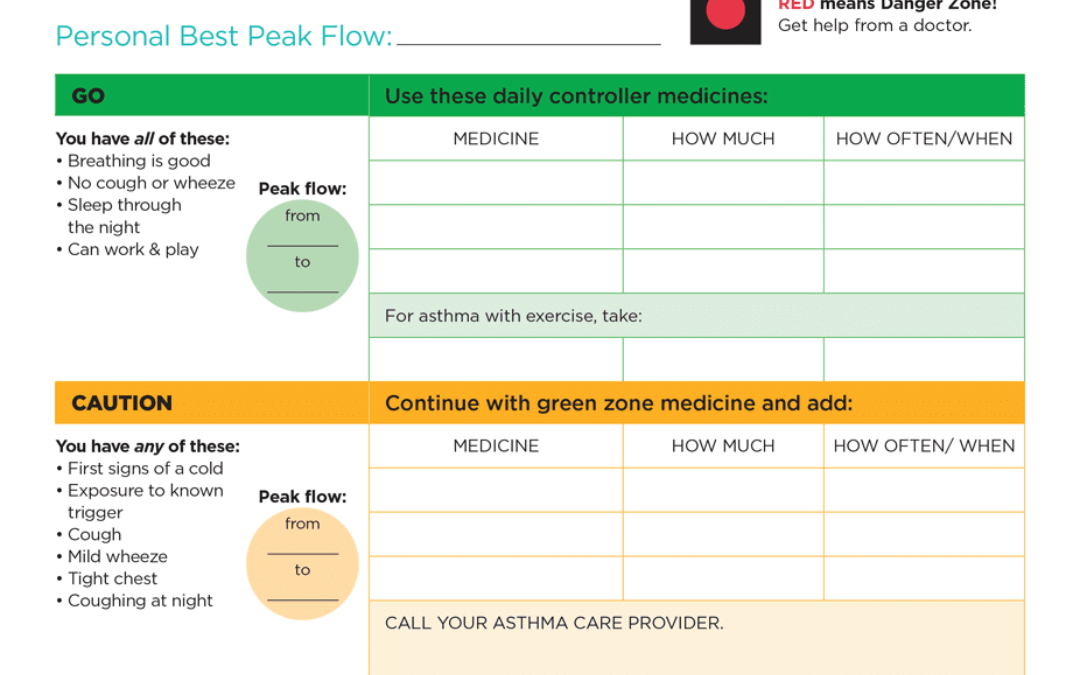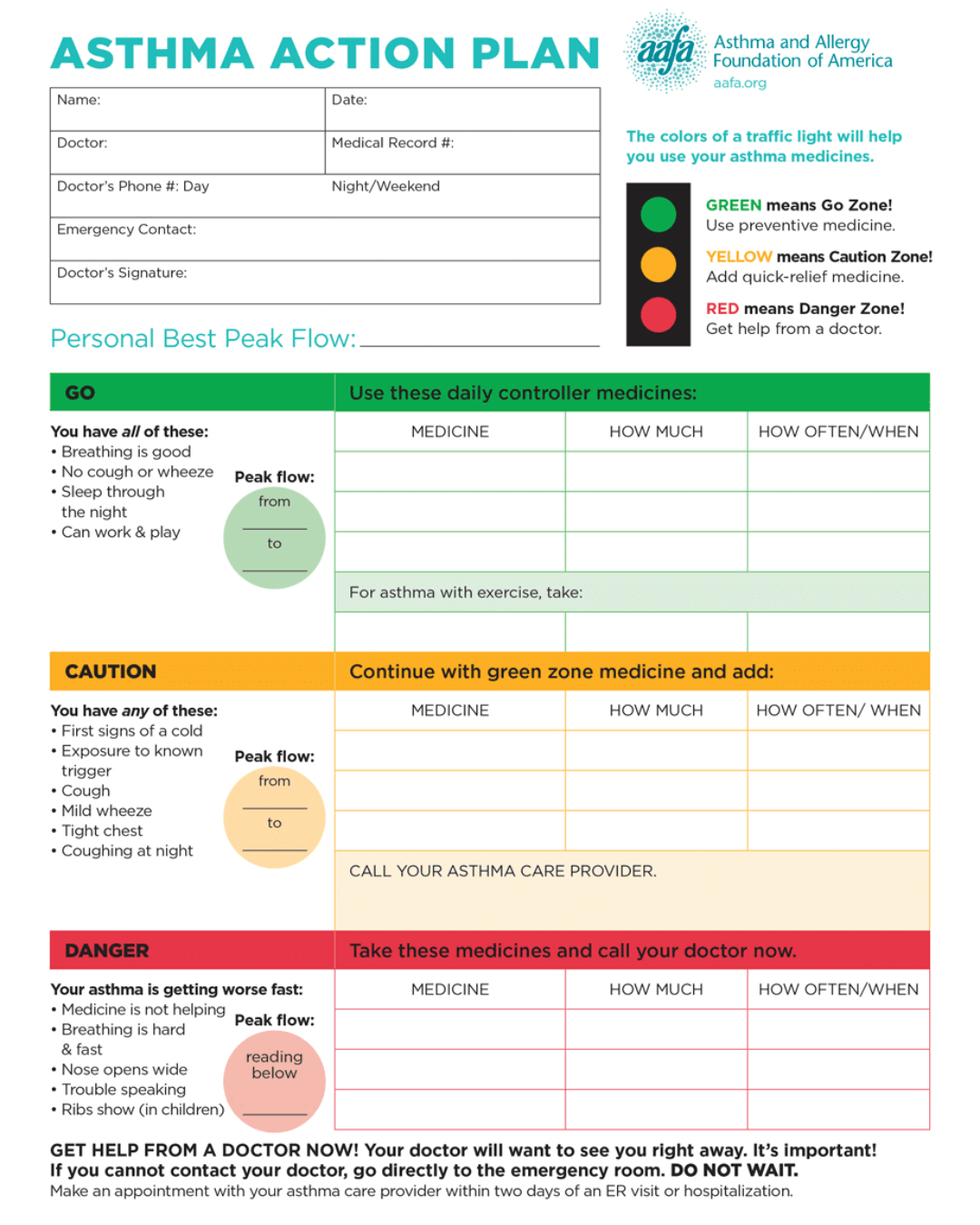Asthma is a chronic condition that affects the airways, making it difficult for individuals to breathe. It’s essential for people with asthma to proactively manage their condition to reduce the risk of flare-ups and maintain a good quality of life. One of the most effective ways to do this is by developing a personalized asthma action plan. This plan serves as a roadmap to monitor symptoms, manage triggers, and know what steps to take during an asthma attack. At Premier Allergy, Asthma, & Sinus Care, we know how to help you manage your asthma.
Understanding Your Asthma
Asthma affects each person differently. To create yourself a tailored action plan, it’s important to first understand your specific triggers, symptoms, and medication needs. Here are some key components:
Common Asthma Triggers
- Allergens: Pollen, pet dander, dust mites, and mold.
- Irritants: Smoke, strong odors, and air pollution.
- Weather: Cold air, humidity, or sudden temperature changes.
- Physical Activity: Exercise-induced asthma can cause symptoms during or after physical exertion.
- Illness: Respiratory infections, such as colds or the flu, can exacerbate asthma.
Recognizing Symptoms
Asthma symptoms can range from mild to severe. Common signs include:
- Shortness of breath
- Wheezing
- Chest tightness
- Persistent coughing, especially at night or early morning
- Fatigue due to difficulty breathing
Why an Asthma Action Plan is Important
An asthma action plan provides clear instructions for managing your condition day-to-day and during emergencies. It helps you:
1. Monitor Symptoms: Track how you’re feeling to catch early signs of a flare-up.
2. Identify Triggers: Pinpoint and avoid situations that worsen your symptoms.
3. Use Medications Correctly: Ensure you’re taking the right medications at the right time.
4. Handle Emergencies: Know exactly what steps to take during an asthma attack, including when to seek medical attention.
Creating Your Asthma Action Plan
An asthma action plan is typically divided into three zones: green, yellow, and red. These zones are based on your symptoms and peak flow readings, which measure how well air moves out of your lungs.
1. Green Zone: Your Asthma is Under Control
The green zone represents your baseline—when you’re feeling good and symptoms are minimal. To stay in the green zone:
- Take daily maintenance medications as prescribed.
- Avoid known triggers.
- Monitor your peak flow readings regularly.
Actions to Take:
- Continue with your long-term controller medications (e.g., inhaled corticosteroids).
- Maintain a healthy lifestyle, including regular exercise and a balanced diet.
2. Yellow Zone: Early Warning Signs
The yellow zone indicates that your asthma is worsening. You may notice increased symptoms, a drop in your peak flow readings, or a need for quick-relief medication more than usual.
Actions to Take:
- Use your rescue inhaler (e.g., albuterol) as directed by your doctor.
- Avoid triggers that might be causing your symptoms.
- Monitor your peak flow readings frequently.
- Adjust your medication under the guidance of your healthcare provider.
3. Red Zone: Asthma Emergency
The red zone signals a severe asthma attack that requires immediate action. Symptoms may include extreme shortness of breath, inability to speak in full sentences, or blue lips/fingertips. Peak flow readings are likely below 50% of your personal best.
Actions to Take:
- Use your rescue inhaler immediately.
- Follow your emergency instructions, such as taking oral corticosteroids if prescribed.
- Seek urgent medical attention or call 911 if symptoms do not improve.
Medications for Asthma Management
Asthma medications fall into two main categories: controllers and relievers.
Controllers
These medications help prevent symptoms and reduce inflammation over time. They include:
- Inhaled Corticosteroids: Fluticasone, budesonide.
- Long-Acting Beta-Agonists (LABAs): Salmeterol, formoterol (usually combined with corticosteroids).
- Leukotriene Modifiers: Montelukast.
Relievers
These fast-acting medications provide immediate relief during flare-ups:
- Short-Acting Beta-Agonists (SABAs): Albuterol.
- Anticholinergics: Ipratropium bromide.
Lifestyle Tips for Asthma Control
In addition to following your action plan, adopting healthy habits can make a big difference in managing asthma:
1. Stay Active: Regular exercise can improve lung function, but consult your doctor about managing exercise-induced symptoms.
2. Practice Good Hygiene: Wash hands frequently to avoid respiratory infections.
3. Maintain a Clean Home: Reduce allergens by vacuuming regularly, using HEPA filters, and controlling humidity.
4. Quit Smoking: If you smoke, seek help to quit—smoking can worsen asthma symptoms.
5. Manage Stress: Practice relaxation techniques like yoga or meditation to reduce stress, which can trigger asthma.
Teaching Others About Your Asthma
It’s essential to educate those around you about your asthma, especially if they’re likely to be present during an emergency. Share your action plan with family, friends, and coworkers. Teach them how to recognize signs of an asthma attack and how they can help.
Reviewing and Updating Your Action Plan
Asthma is a dynamic condition, and your action plan should evolve with your needs. Some schools may require an action plan and we are happy to help assist in this. Be sure to keep yours updated if:
- Your symptoms change.
- You experience frequent flare-ups.
- You’ve had an emergency visit for asthma.
When to Seek Emergency Care
While an asthma action plan can help you manage most situations, it’s critical to know when professional medical help is necessary. Seek emergency care if you:
- Struggle to breathe or speak.
- Do not respond to your rescue inhaler.
- Have symptoms that worsen rapidly.
- Experience chest pain or a bluish tint to the lips or fingers.
Asthma doesn’t have to control your life. By staying on top of your symptoms and creating a comprehensive asthma action plan, you can breathe easier and enjoy a healthier, more active lifestyle.






